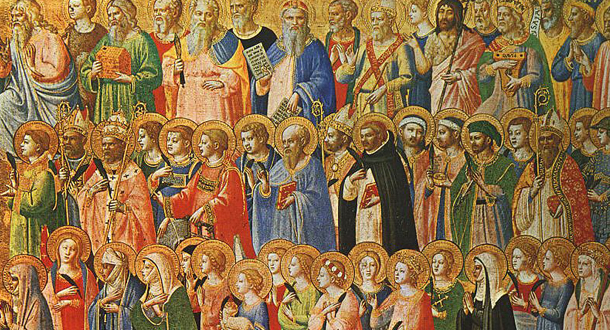 Solemnity of All Saints
Solemnity of All Saints
Scripture:
Revelation 7:2-4, 9-14
1 John 3:1-3
Matthew 5:1-12a
Reflection:
The feast of All Saints is surely one of the most beautiful days in the Catholic liturgical year. The “saints” referred to include not only the great canonized saints the Church lifts up in a formal way for our inspiration, but all of the beloved dead whom each of us know who were good and faithful people even as they were truly human with all of the normal faults and failings each of us has. We trust that these “holy ones” enjoy the fullness of peace and joy in God’s loving presence.
But in the long tradition of the church reaching back to the New Testament itself, the designation “saint” is not limited to those who have gone before us. When writing to his fellow Christians in the various community he had evangelized, Paul would refer to them in Greek as “hagioi”, that is, the “holy ones” or “saints.” Paul was convinced that through baptism, every follower of Jesus was immersed in the death and resurrection of Christ. We die to sin, that is, we are liberated from the radical power of sin and able to be alive in Christ.We become transformed by the power of God’s Spirit and become truly and fundamentally “holy.”
That is why Paul could describe the Christians in such in such remarkable ways—as being “in Christ,” as “temples of the Holy Spirit,” as “members of the Body of Christ,” as “new creations,” and as “daughters and sons of God.” Even with our lingering failings, Paul believed we are precious in God’s eyes and capable of great virtue and holiness. We are “saints” in this radical sense.
The Scripture readings for this great feast echo this same perspective. This particularly true of the reading from the First Letter of John, one of most beautiful books of the New Testament. The author reminds us at the outset that through the love of God we are able to be called “children of God.” Our present state as beloved children of God is, in a sense, a warm-up for what we shall become: “We do know that when it is revealed we shall be like him, for we shall see him as he is.” The first account of creatin in Genesis affirms that we were made “in the image and likeness” of God, and the second account of creation describes the human being as a “bag of clay” into which God breathes the spirit of life. John continues that biblical tradition in affirming that we “shall be like God..”
What should be the characteristics of those who bear the image of God? The Gospel reading from the Sermon on the Mount in Matthew’s Gospel gives us a glimpse of the qualities of those who are the “sons and daughters” of God. They are those who adopt God’s favor for people who are vulnerable and in need: the poor, those who mourn, the meek or oppressed peoples, those who “hunger and thirst” for justice. And they reflect the very attitudes of Jesus’ himself: merciful, clean of heart, peacemakers, willing to endure opposition and suffering in witnessing to the gospel.
The feast of All Saints that we celebrate today honors the full expanse of God’s family—those who have gone before us into the abundance of God’s love and blessing; those of us here on earth who have been endowed with God’s own image and strive to live in a way that reflects our true nature as children of God.
Fr. Donald Senior, C.P. is President Emeritus and Professor of New Testament at Catholic Theological Union. He lives at the Passionist residence in the Hyde Park neighborhood of Chicago.
